Abstract
Purpose: Research encompassing the characteristics of chiropractic students is limited. The purpose of our study was to evaluate a current chiropractic student population enrolled at a chiropractic college concerning demographics, expectations, and beliefs. Methods: A 44-item survey was administered to volunteer participants. Direct verbal interaction in a classroom setting to potential participants was the recruitment strategy used. Data were collected and stored on a safe network. Percentages for all responses were calculated and means were recorded where appropriate. Results: A total of 664 students participated of 877 potential eligible candidates (75%). The respondents tended to be 21–25 years of age, Caucasian, and male. Most respondents expected to work in a private practice immediately following graduation and anticipated an annual income of at least $100,000 eventually. Respondents preferred the retaining of the term, “subluxation,” and identified the importance of new and emerging scientific data. Additionally, respondents held the viewpoint that some non-musculoskeletal diseases can be treated effectively with spinal manipulation as a primary treatment. Conclusions: The majority of chiropractic students in our study were represented by specific demographic characteristics, and a strong favoritism toward the expectations of working in a private practice setting and earning at least $100,000 per year at some point in their career. Distinct beliefs are shared between chiropractic students and practicing chiropractors in North America, and certain aspects of students in our study are comparable to chiropractic students in similar studies.
Key Indexing Terms: Attitude, Chiropractic, Cross Sectional Survey, Education, Students
INTRODUCTION
Chiropractic is described as a health care profession that focuses on the relationship between the body's primary structures, particularly the spine, nerves, and muscles, and patient's health.1 Chiropractors approach the body with the goal of alleviating pain, improving function, and supporting the body's natural potential to heal itself.2 Chiropractic is the largest single complementary and alternative medicine (CAM) profession in the United States. Currently, there are more than 88,000 active chiropractic licenses3 and more than 49,000 practicing chiropractors in the United States. By the year 2018, it is estimated the number of practicing chiropractors will increase to more than 58,000.4
The public identifies chiropractors mostly as practitioners who treat musculoskeletal disorders, particularly low back pain. Thus, the majority of visits to chiropractors are comprised of patients seeking treatment for spine-related disorders.5–9 Chiropractors typically use spinal manipulative therapy (SMT) as a form of primary intervention, often coupled with other forms of conservative treatment, such as manual myofascial therapy, exercise prescription, healthy lifestyle coaching, and nutritional/diet counseling. Despite public perception, the chiropractic profession historically has encountered difficulty in agreeing on what disorders appropriately merit the use of SMT and other typical chiropractic interventions. Furthermore, the profession has experienced bouts of angst concerning the suitable role and identity of chiropractic in the health care system.10 It has been posed that chiropractic is at a crossroads in the profession and educational system.11–14 The present-day chiropractic student represents the next generation of leaders to mold the profession in this time of flux. We surmise that ideologies and expectations of current chiropractic students may have a role in the development of the chiropractic profession, including those represented by current students at Logan College of Chiropractic.
Research encompassing chiropractic students' characteristics currently is limited and is an applicable subgroup worthy of assessment. The purpose of our study was to evaluate a current chiropractic student population enrolled at Logan College of Chiropractic in three main categories: (1) demographics and pre-chiropractic college experience, (2) practice/postgraduate expectations, and (3) chiropractic philosophic beliefs.
METHODS
An anonymous cross-sectional survey was administered to students enrolled in the Logan College of Chiropractic Doctor of Chiropractic degree program. Participation was voluntary for each student and sampling was based on the convenience of student availability. Approval from the Logan College of Chiropractic Institutional Review Board was obtained.
Inclusion Criteria
Participants in our study must have been enrolled currently in the Logan College of Chiropractic Doctor of Chiropractic degree program to participate. Each participant must not have been enrolled for more than the maximum allowed 15 successive trimesters in the Doctor of Chiropractic degree program. This criterion allowed for sampling of our desired population students.
Exclusion Criteria
Any Logan University students enrolled in a bachelor of science degree and/or master of science degree without concurrently being enrolled in the Logan College of Chiropractic Doctor of Chiropractic degree program were considered ineligible for this study. All formerly enrolled and prospective students of the Logan College of Chiropractic Doctor of Chiropractic degree program additionally were excluded from this investigation.
Recruitment
We used direct verbal interaction in a classroom setting to potential participants as the recruitment strategy to reach our desired population. Each investigator presented to randomly selected classes and verbally volunteered an opportunity for students to partake in an anonymous survey for the benefit of research in the chiropractic profession. We chose this method of recruiting due to the ability to invite a large percentage of students to participate, and to administer the study in a comprehensive and timely manner. The chiropractic degree program typically requires a minimum of 10 trimesters and a maximum of 15 consecutive trimesters of enrollment to complete. Typical program status and curriculum mirrors coursework delivered in a designated 10 trimester fashion, therefore labeling students as a “trimester 1” student, “trimester 2” student and so on up to a “trimester 10” student classification. A professor delivering instruction for a course representing each trimester class was contacted for permission to deliver our survey. With permission from each instructor, a range of 20–30 minutes was used at the beginning of the course at each represented trimester class for participant recruiting, explaining the title and purpose of the study, obtaining verbal consent to participate, describing procedures for the anonymous and voluntary nature of the survey, describing potential risks and benefits of participation, and subsequently administering the survey. Participants were instructed verbally to respond to each question of the survey and mark the one most appropriate corresponding response on the Scantron testing document that was distributed to each participant. Participants were instructed verbally to remain silent during the administration of the survey and not discuss any details of the survey until the survey was complete. Furthermore, the participants were directed verbally to refrain from marking or writing on the survey instruments. Upon each participant's completion, the survey instruments and Scantron testing documents were collected. Administration of the survey for each represented trimester class took approximately one month to complete.
Survey Questionnaire
We developed a 44-item questionnaire, displayed in Appendix A, consisting of three topic groups: (1) demographics and pre-chiropractic college experience, (2) practice/post-graduate expectations, and (3). chiropractic philosophical beliefs. The first group of questions, labeled “Demographics and Experience,” was constructed of eight questions designed in a multiple choice answer format, with instructions to choose the one most applicable answer. The second set of questions, labeled “Attitude of Future Career Characteristics,” consisted of 12 questions representing survey questions 9–20. This second set of questions also was arranged in a multiple choice answer format with instructions to choose the one most applicable answer. The final category of questions, labeled “Chiropractic Philosophical Beliefs,” consisted of 24 questions, representing survey questions 21–44. Questions 21 and 22 were designed in a multiple choice format with instructions to choose the one most applicable answer, while questions 23–44 were created in a 5-point Likert scale format. Responses to the survey for each participant were completed on a standard Scantron testing document.
Data Analysis
Responses were scanned, categorized and transferred onto a text file, and subsequently stored on the college's safe network. Data were summarized as percentages for all question responses and calculated means for responses to questions deemed appropriate.
RESULTS
Of a possible 877 potential eligible students, 664 chiropractic students participated voluntarily in our study, yielding a 75% participation rate. The study failed to produce a 100% completion rate for each question and, therefore, a variance of 642–664 responses are recorded per item. Table 1 illustrates response percentages of participant demographic and experience background. The respondents were represented mostly by groups 21–25 years of age (63.1%), Caucasians (91%), and males (63.4%). The majority of respondents were reported to have been treated by a chiropractor before enrollment (84%) and to have no relatives who have attended or are attending chiropractic school (85.6%). The bulk of students were reported to have previously completed a bachelor's degree (67%) and a large portion of students reported an undergraduate GPA of 3.01–3.50 (46.5%).
Table 1.
Demographics and experience.

Table 2 represents the second section of the survey, encompassing questions related to attitudes of future career characteristics. The respondents showed strong favoritism toward the expectation of working in a private practice immediately following graduation (89.1%) and anticipated an income of at least $100,000 at some point in their career. Table 2 displays each item in this section with its corresponding response percentages.
Table 2.
Attitudes of future career characteristics.
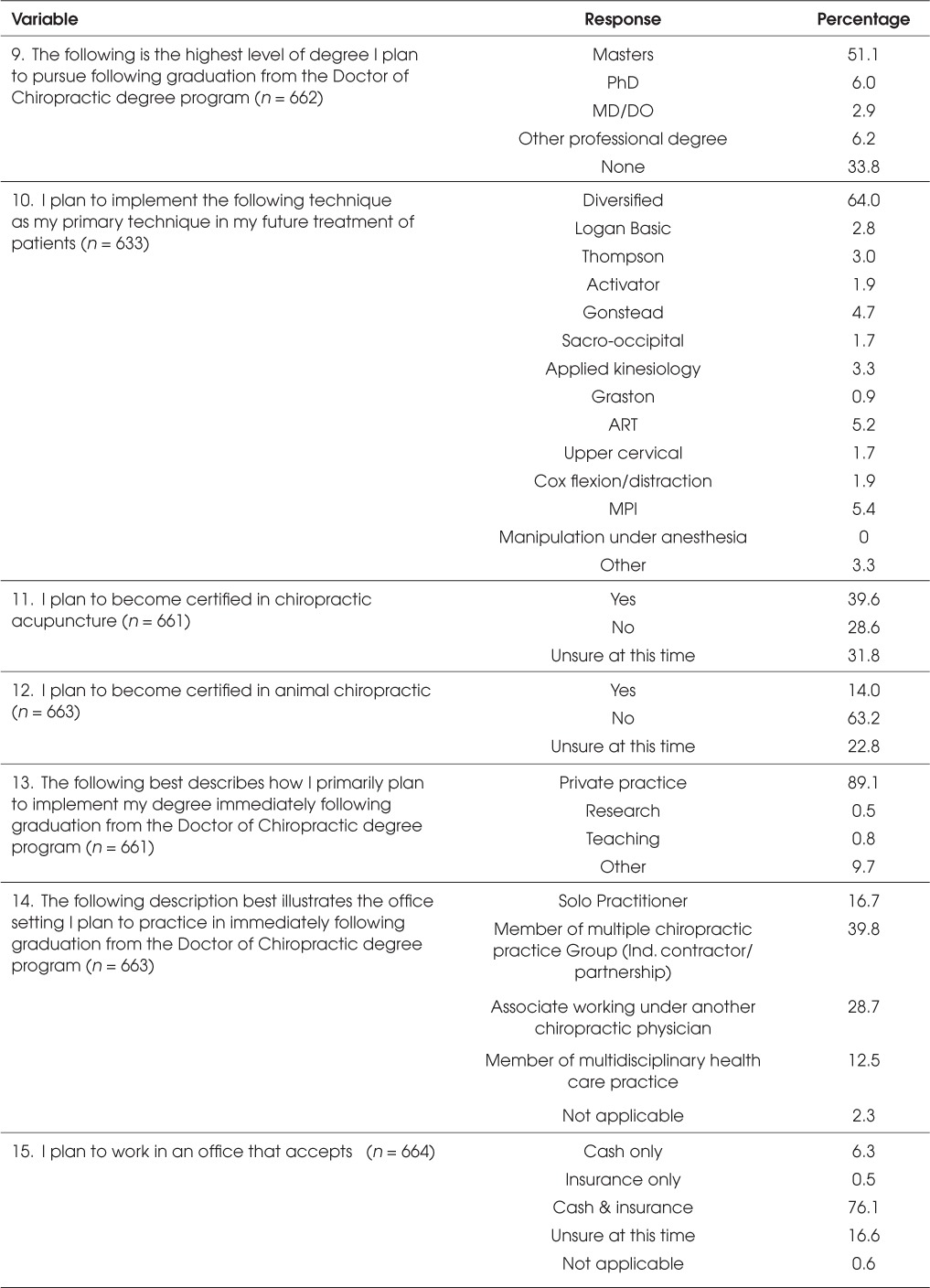
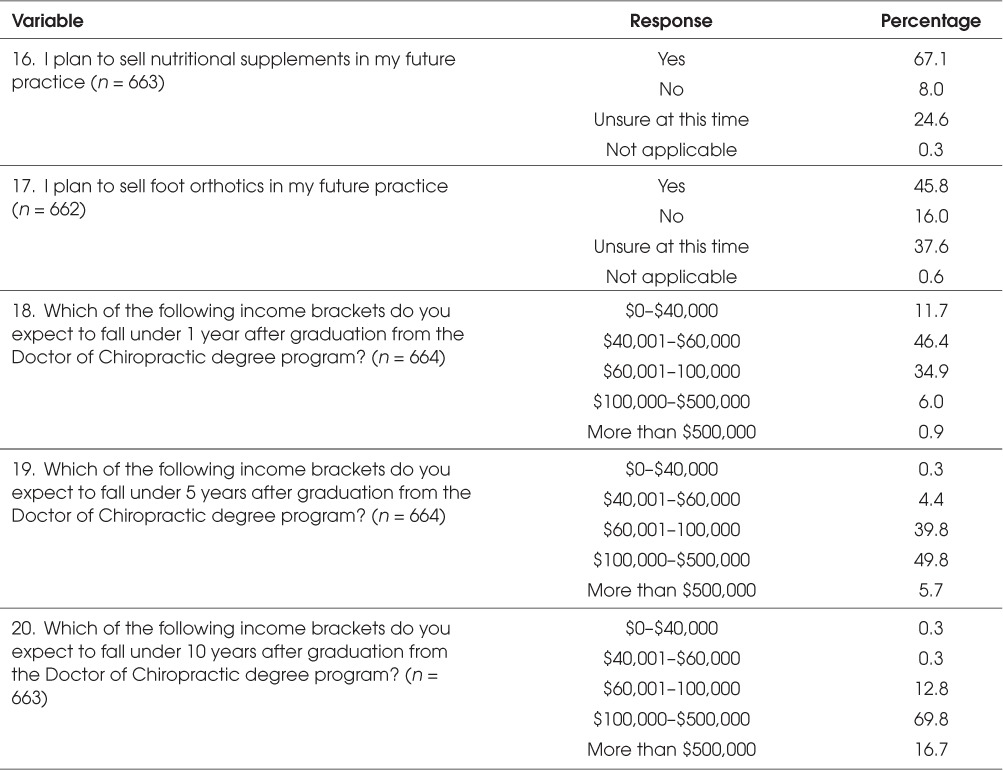
Table 3 shows the first two items and response percentages of the section encompassing chiropractic philosophical beliefs. The majority of respondents felt a minimum of a 3.0 undergraduate GPA must be achieved for consideration of admission into chiropractic school (49.7%). Additionally, a preference to avoid a narrowing of the chiropractic scope of practice to one paradigm was shown (71.2%).
Table 3.
Chiropractic philosophic beliefs.
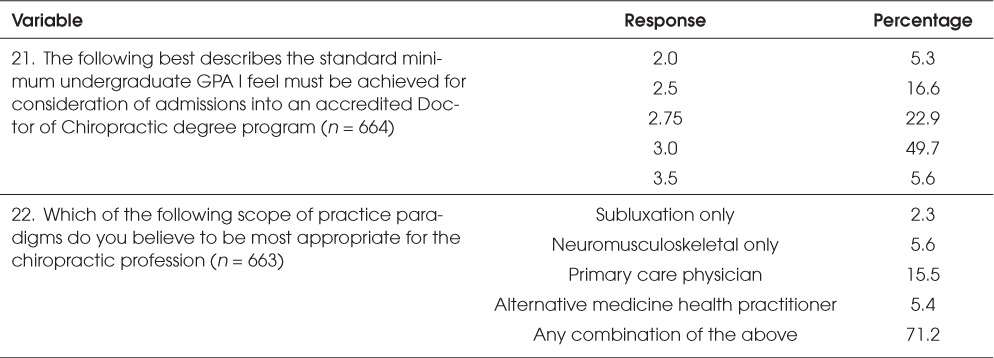
Table 4 displays the percentages and mean of responses to each question concerning the topic of chiropractic philosophic beliefs. Respondents had a mean of 2.21 concerning the profession holding strongly to the term, “sub-luxation” (1 = Strongly Agree, 5 = Strongly Disagree). Participants overwhelmingly reported to “Strongly Agree” or “Agree” with the statement that new and emerging data are more important than traditional chiropractic theory for the advancement of the chiropractic profession, displaying a mean of 1.99. The majority of respondents reported to “Agree” that chiropractic adjustments are an effective primary treatment for hypertension (39.1%), asthma (46.0%), otitis media (41.3%), and depression (33.9%), that all patients should undergo an X-ray before treatment with spinal manipulation (25.1%), and that it is appropriate for every person to receive chiropractic adjustments beginning at birth (37.7%). Additionally, respondents reported to favor the idea that it is appropriate for every person to receive chiropractic adjustments for their entire life, showing a mean response of 1.90.
Table 4.
Chiropractic philosophical beliefs.
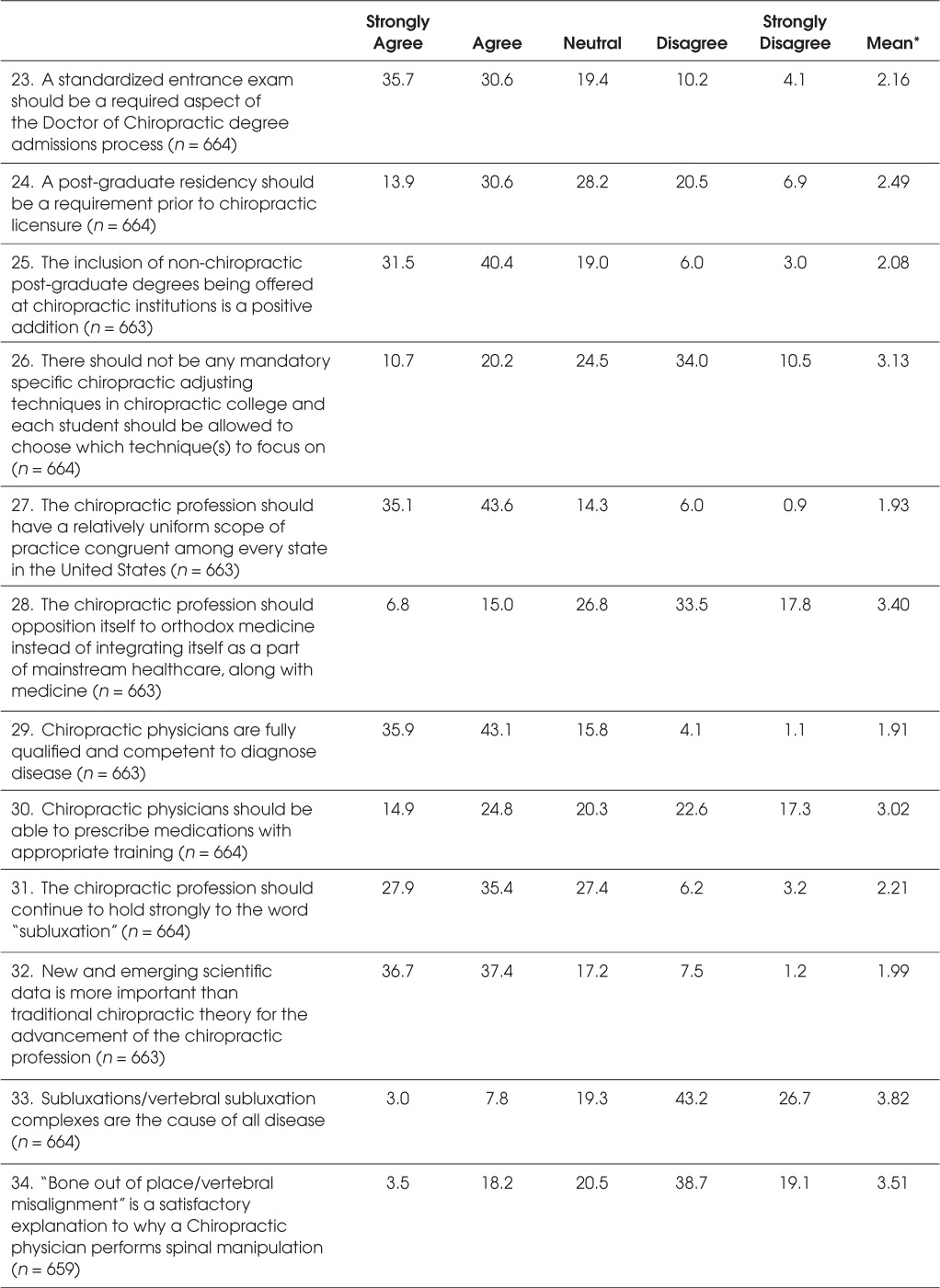
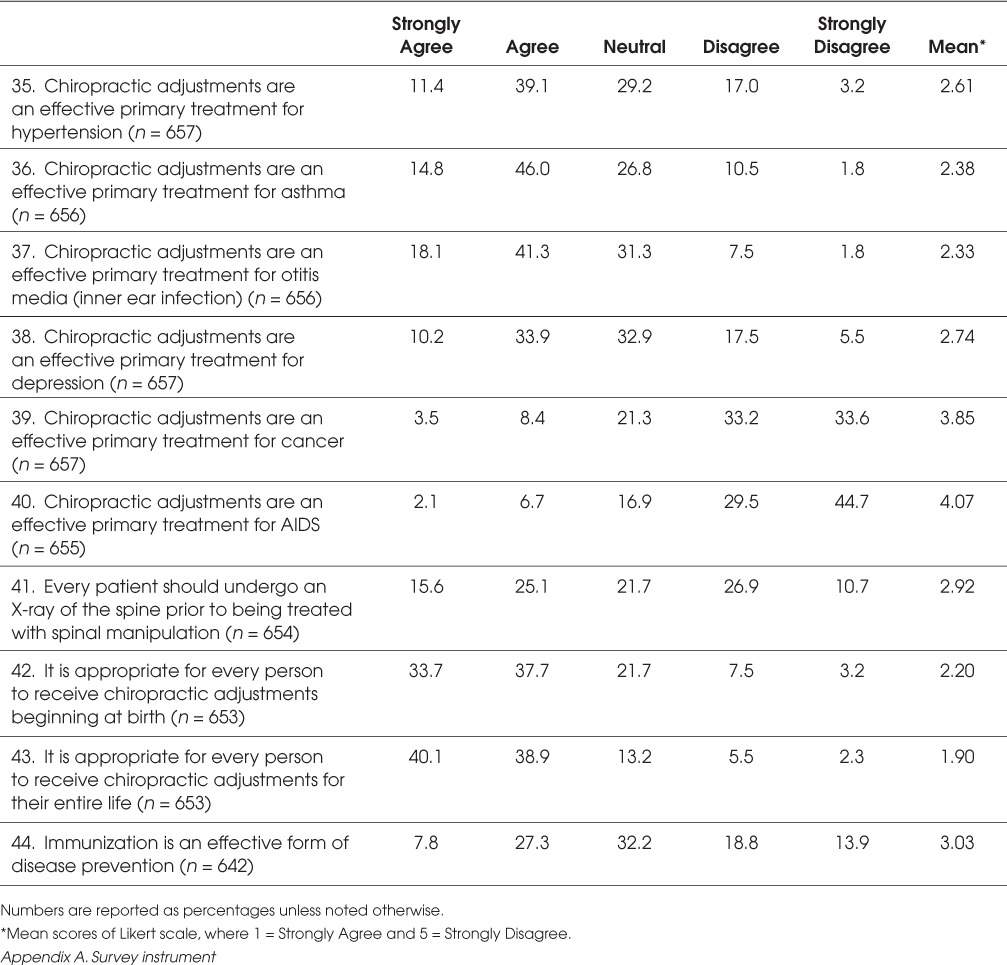
DISCUSSION
The rate of participation in this cross-sectional study was strong, despite using one student recruitment method. This exemplifies the strength of our approach to contact students in a classroom setting to offer participation and administer the study simultaneously. The 25% non-response rate may be attributed to the absence of students from the particular class of survey administration on that day or recruits who decided to not participate in our study.
Previous surveys among North American chiropractors, although limited, have resulted in a specific theme of thoughts and patterns of practicing chiropractors. The results of this survey indicate that current students enrolled in Logan College of Chiropractic Doctor of Chiropractic degree program share certain views with practicing North American chiropractors.
Students participating in our study share views with practicing chiropractors in North America regarding the retaining of the term “subluxation.”15 Respondents in this survey exhibit an overall neutral stance regarding the appropriateness of chiropractors prescribing medication accompanied by appropriate training. Practicing chiropractors remain neutral on the topic of chiropractic rights to prescribing over-the-counter medications and medications relating to musculoskeletal conditions; however, they overwhelmingly oppose the right to prescribe all medicines.15
Respondents of this survey indicated a trend of support of the importance for new and emerging scientific data over traditional chiropractic theory. However, the respondents implied an overall ideology of support for chiropractic adjustments being a worthy primary treatment for hypertension, asthma, otitis media, and depression, despite the lack of supporting evidence.16 Practicing North American chiropractors share a similar viewpoint, reporting that chiropractic adjustments elicit improvement in some non-musculoskeletal ailments.15 Furthermore, participants represented a support for the practice of performing a spinal X-ray on each patient before treating with spinal manipulation, even though current guidelines strongly oppose this idea.17,18 Respondents held the unsubstantiated notions that each individual should receive chiropractic adjustments and each individual should receive chiropractic adjustments for life.
Like students in past studies that have investigated chiropractic students, the majority of students in our study came from non-chiropractic family backgrounds.19 Respondents of this study held comparable expectations of student respondents in similar studies, expecting to earn more than $100,000 annual income.20
It is noteworthy to mention the results from our study are a result of specific sampling of students narrowed to one individual institution at one particular point in time. The responses may result from a bias of a particular common theme of student demographics and/or philosophic beliefs that represent the student body at this institution at this time in history. Differences among chiropractic students at differing chiropractic institutions at different segments in history may offer contrary results to the collected data in our study. Future studies relating to this theme should concentrate on expanding the participant profile to other students enrolled in North American chiropractic colleges. Future investigations focusing on topics similar to our study should include more specific and probing questions regarding views on the future of the profession. Inquiries into the originations of philosophic beliefs of chiropractic students should become an area of future study.
Limitations
Our study was limited by non-response, possibly yielding a degree of response bias similar to other studies.21 The survey contained grammatical and typographical errors, enhancing the opportunity to misunderstand the question, resulting in an invalid response. Response/recall error, such as difficulty recalling and reporting accurate undergraduate GPA, may have influenced the results of our study. An unclear definition of “Income” may have affected accurate responses for questions 18–20 of the survey. Responses for questions 36–40 may have been influenced by potential ambiguity from the wording of the questions. Respondents may have had difficulty understanding the intended definition of “primary treatment” in questions 36–40, resulting in potential response error. Additional response bias may have been present due to the length of time to administer the survey to each individual class. Discussion among students who had and had not yet participated may have affected responses. Similar to other studies of this nature, the self-reporting form of this survey data may be interpreted as being personal in nature, provoking disapproval of the study.14 Statistical analysis was limited due to time constraints, a lack of access to proper format storage, and analysis software.
CONCLUSION
The results of the survey show a relationship between the opinions of current chiropractic students and the opinions of currently practicing chiropractors on related questionnaires. Certain aspects of student demographics and income expectations are comparable to previous studies of chiropractic students. Current chiropractic students represent the newest wave of chiropractic practitioners, and the opinions of current students enrolled at Logan College of Chiropractic may influence how the chiropractic profession continues to develop in a modern and ever-changing health care system.
ACKNOWLEDGEMENTS
Dr John Gutweiler participated in saving the response data on the Logan College of Chiropractic University Programs safe network.
Appendix A. Survey Instrument

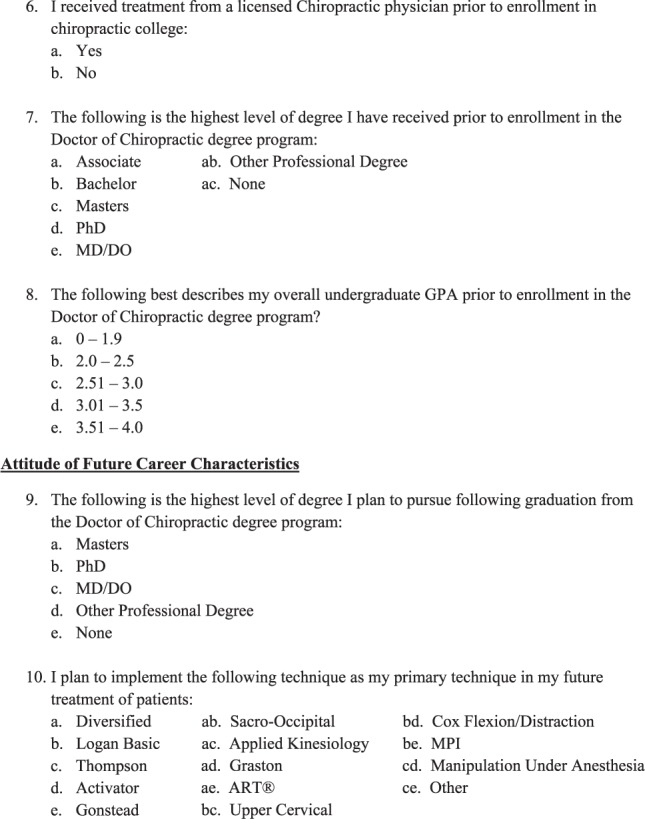
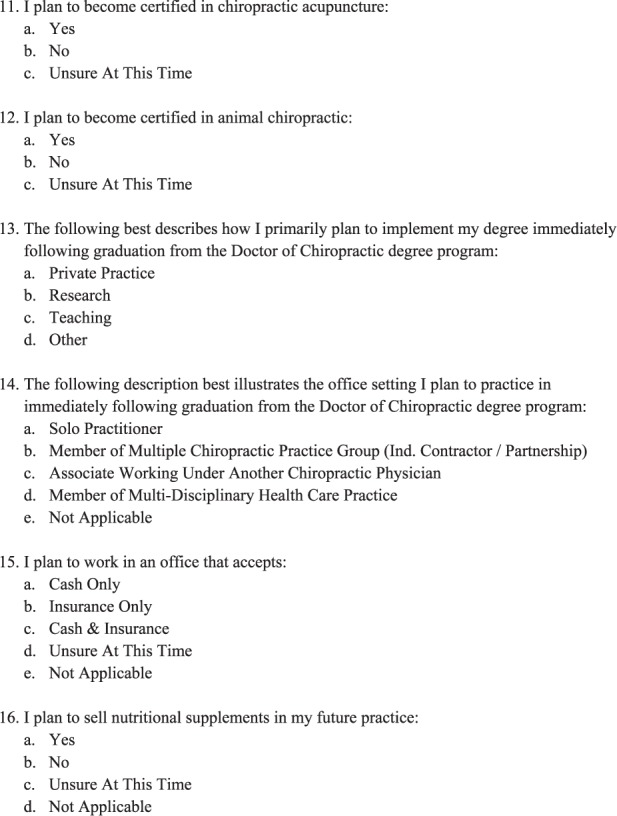
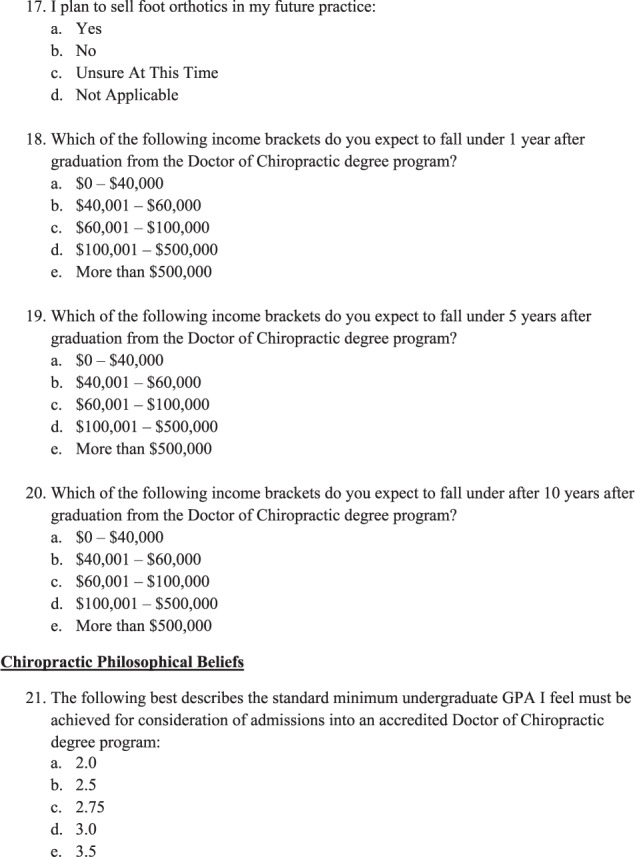
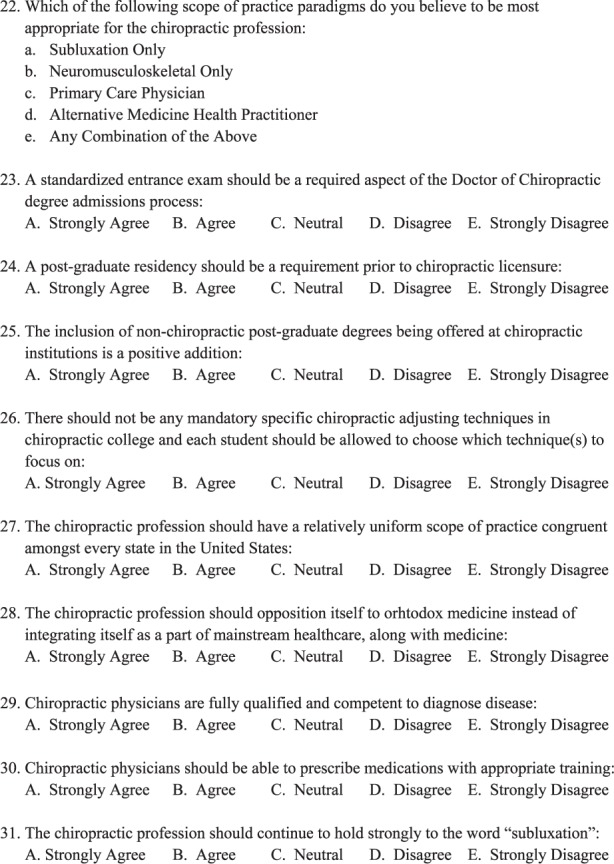
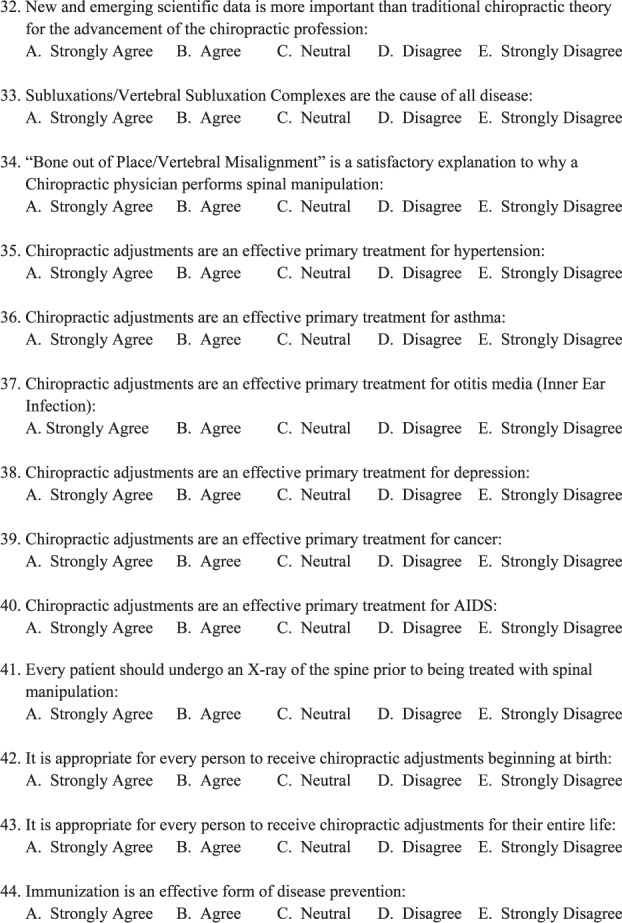
Footnotes
CONFLICTS OF INTEREST
The authors have no competing interests to declare.
REFERENCES
- 1.Association of Chiropractic Colleges. What is Chiropractic? http://www.chirocolleges.org/whatis.html. Accessed February 22, 2012.
- 2.National Center for Complementary and Alternative Medicine. Chiropractic, Spinal Manipulation, and Osteopathic Manipulation. http://nccam.nih.gov/health/chiropractic. Accessed February 8 and February 22, 2012.
- 3.Federation of Chiropractic Licensing Boards. Licensure Statistics By U.S. States. http://directory.fclb.org/Statistics/LicensureStatisticsUS/tabid/157/Default.aspx. Accessed July 29, 2011.
- 4.United States Department of Labor. Bureau of Labor Statistics. http://www.bls.gov/oco/ocos071.htm#outlook. Accessed July 29, 2011.
- 5.Shekelle PG, Brook RH. A community based study of the use of chiropractic services. Am J Public Health. 1991;81(4):439–442. doi: 10.2105/ajph.81.4.439. [DOI] [PMC free article] [PubMed] [Google Scholar]
- 6.Christensen M, Kollasch M, Hyland JK. Practice Analysis of Chiropractic. Greeley, CO: National Board of Chiropractic Examiners; 2010. [Google Scholar]
- 7.Nyiendo J, Haldeman S. A prospective study of 2,000 patients attending a chiropractic college teaching clinic. Med Care. 1987;25(6):516–527. doi: 10.1097/00005650-198706000-00006. [DOI] [PubMed] [Google Scholar]
- 8.Coulter ID, Hurwitz EL, Adams AH, Genovese BJ, Hays R, Shekelle P. Patients using chiropractors in North America: who are they, and why are they in chiropractic care? Spine. 2002;27(3):291–296. doi: 10.1097/00007632-200202010-00018. [DOI] [PubMed] [Google Scholar]
- 9.Ailliet L, Rubinstein SM, de Vet HC. Characteristics of chiropractors and their patients in Belgium. J Manipulative Physiol Ther. 2010;33(8):618–625. doi: 10.1016/j.jmpt.2010.08.011. [DOI] [PubMed] [Google Scholar]
- 10.Hawk C. Evidence of chiropractors' views on identitiy: who do we think we are? J Am Chiropr Assoc. 2004;41(5):43–50. [Google Scholar]
- 11.Meeker WC, Haldeman S. Chiropractic: a profession at the crossroads of mainstream and alternative medicine. Ann Intern Med. 2002;136(3):216–227. doi: 10.7326/0003-4819-136-3-200202050-00010. [DOI] [PubMed] [Google Scholar]
- 12.Reggars JW. Chiropractic at the crossroads or are we just going around in circles? Chiropr Man Therap. 2011;19:11. doi: 10.1186/2045-709X-19-11. [DOI] [PMC free article] [PubMed] [Google Scholar]
- 13.Willis E. Chiropractic & osteopathy at the crossroads: opening address to COMSIG Chiropractic Conference—7th November 1992. COMSIG Rev. 1993;2(1):1–4. [PMC free article] [PubMed] [Google Scholar]
- 14.Wyatt LH, Perle SM, Murphy DR, Hyde TE. The necessary future of chiropractic education: a North American perspective. Chiropr Osteopat. 2005;13:10. doi: 10.1186/1746-1340-13-10. [DOI] [PMC free article] [PubMed] [Google Scholar]
- 15.McDonald WP. Ohio Northern University. Institute for Social Research. How Chiropractors Think and Practice: The Survey of North American Chiropractors. Ada, Ohio: Institute for Social Research, Ohio Northern University; 2003. [Google Scholar]
- 16.Bronfort G, Haas M, Evans R, Leininger B, Triano J. Effectiveness of manual therapies: the UK evidence report. Chiropr Osteopat. 2010;18:3. doi: 10.1186/1746-1340-18-3. [DOI] [PMC free article] [PubMed] [Google Scholar]
- 17.Bussières AE, Taylor JA, Peterson C. Diagnostic imaging practice guidelines for musculoskeletal complaints in adults-an evidence-based approach-part 3: spinal disorders. J Manipulative Physiol Ther. 2008;31(1):33–38. doi: 10.1016/j.jmpt.2007.11.003. [DOI] [PubMed] [Google Scholar]
- 18.Flynn TW, Smith B, Chou R. Appropriate use of diagnostic imaging in low back pain – a reminder that unnecessary imaging may do as much harm as good. J Orthop Sports Phys Ther. 2011;41(11):838–846. doi: 10.2519/jospt.2011.3618. [DOI] [PubMed] [Google Scholar]
- 19.McNamee KP, Magarian K, Phillips RB. Chiropractic education: a student survey. J Manipulative Physiol Ther. 1990;13(9):521–531. [PubMed] [Google Scholar]
- 20.Zhang J, Rupert R, Nosco D, Tepe R. Financial experience, knowledge, and attitudes among chiropractic students in college. J Chiropr Educ. 2003;17:120–145. [Google Scholar]
- 21.Banzai R, Derby DC, Long CR, Hondras MA. International web survey of chiropractic students about evidence-based practice: a pilot study. Chiropr Man Therap. 2011;19(1):6. doi: 10.1186/2045-709X-19-6. [DOI] [PMC free article] [PubMed] [Google Scholar]


